Introduction
Fashion today faces intense pressure: speeding up trend cycles, reducing waste, keeping customers inspired and doing it all profitably. Artificial Intelligence is stepping in as a game-changer – enabling hyper‑personalization, smarter forecasting, and sustainable operations. This deep dive explores how AI is reshaping the fashion ecosystem with real-world use cases and strategic insights.
What is AI and Why Does It Matter in Fashion?
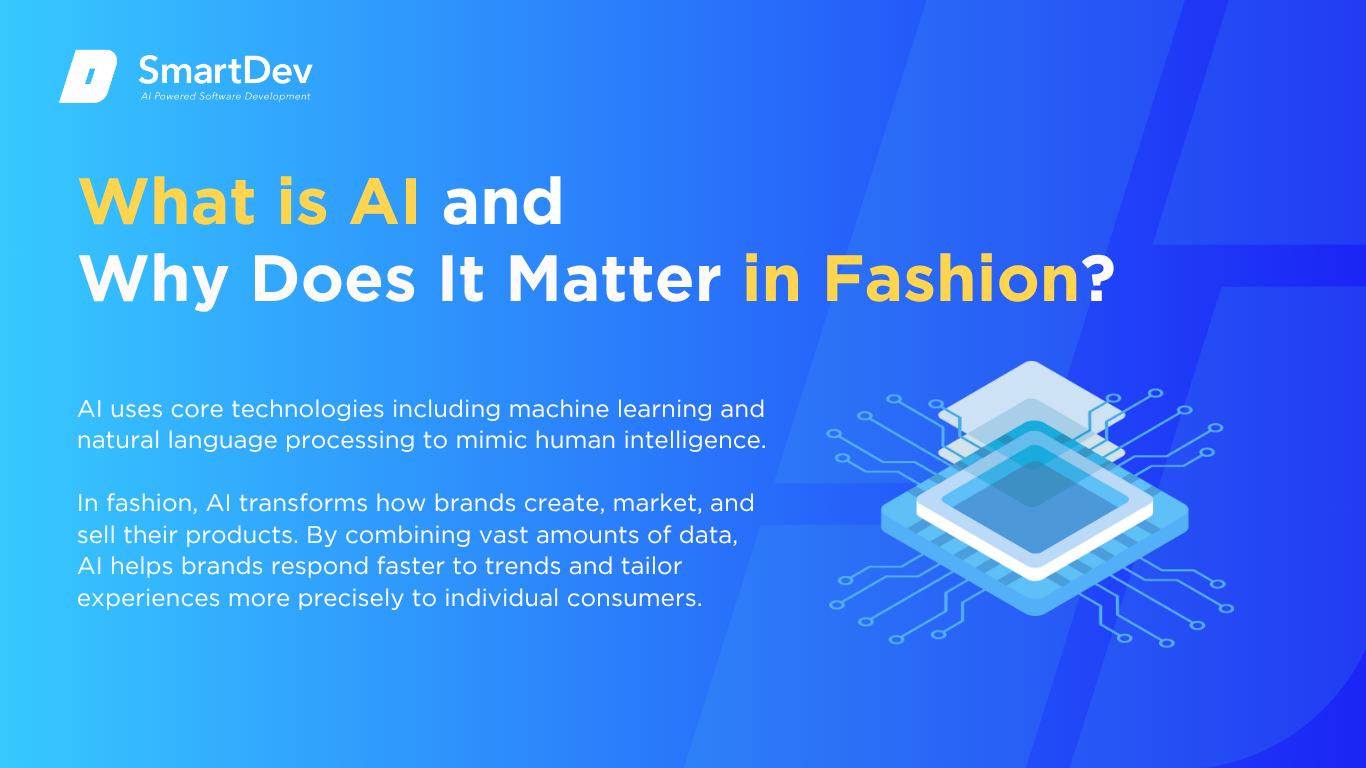
Definition of AI and Its Core Technologies
Artificial Intelligence refers to the ability of machines to perform tasks that would normally require human intelligence. These tasks include recognizing patterns, learning from data, making decisions, and understanding language or images. The core technologies powering AI include machine learning, computer vision, and natural language processing.
In fashion, AI transforms how brands create, market, and sell their products. It enables systems to analyze images, understand style preferences, and even generate design ideas from simple text prompts. By combining vast amounts of visual and behavioral data, AI helps brands respond faster to trends and tailor experiences more precisely to individual consumers.
The Growing Role of AI in Transforming Fashion
Fashion brands are using AI to forecast trends and guide design choices with greater precision. By scanning millions of images and social posts, AI detects emerging styles before they become mainstream. This allows faster, data-driven decisions that keep collections relevant and timely.
Designers use AI tools to generate new looks, test variations, and visualize pieces digitally without creating physical samples. These capabilities streamline workflows and reduce production waste. As a result, brands can innovate faster while improving sustainability.
In retail, AI enhances personalization with smart recommendations and virtual styling. Platforms adapt suggestions based on user behavior and preferences to boost engagement. This creates a more tailored shopping experience that drives higher conversions.
Key Statistics and Trends Highlighting AI Adoption in Fashion
In 2024, 73% of fashion executives ranked generative AI as a top priority, yet only 28% were actively using it in product development. Equity investment in generative AI startups reached $14 billion in H1 2023, showing high investor confidence.
The global AI in fashion market was valued at $2.23 billion in 2024, projected to reach $60 billion by 2034, growing at a 39% CAGR. Meanwhile, generative AI in fashion is forecast to grow from $96.5 million in 2023 to $2.23 billion by 2032.
According to McKinsey, generative AI could add $150–$275 billion in operating profit to the fashion, apparel, and luxury sectors within five years. Morgan Stanley reports AI adoption in consumer and apparel companies rose from 20% to 44% in the first half of 2025. These figures point to a fast-maturing market with rising returns.
Business Benefits of AI in Fashion
AI is creating measurable value across the fashion value chain – from design and production to marketing and customer experience. By addressing key inefficiencies and enabling smarter decision-making, AI is helping brands stay agile, reduce waste, and better serve today’s demanding consumers.
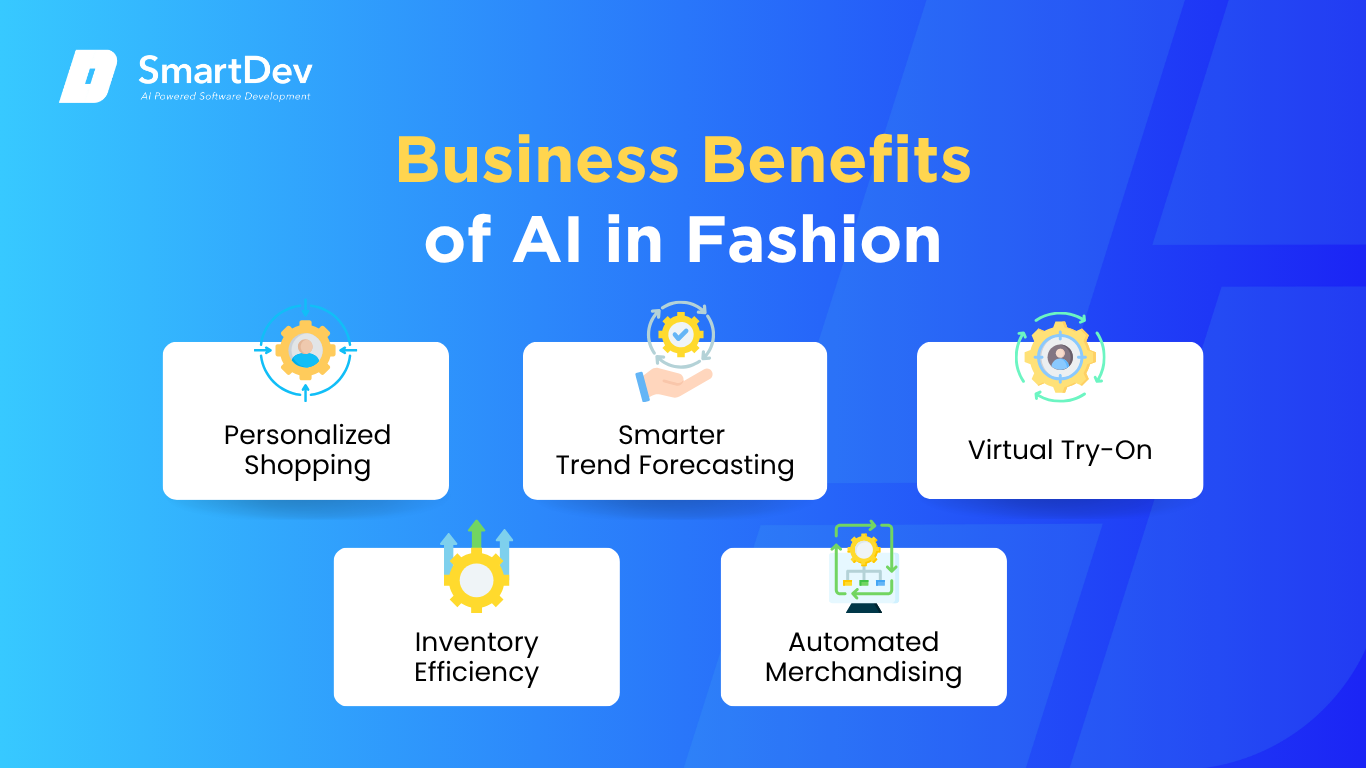
1. Personalized Shopping
AI enables fashion retailers to offer highly personalized recommendations based on browsing history, past purchases, and individual preferences. Tools like THE YES and Stitch Fix use machine learning to tailor product suggestions, improving engagement and increasing conversion rates. This level of personalization builds stronger brand loyalty and helps reduce decision fatigue for shoppers.
Advanced AI chatbots and virtual stylists enhance interactivity, particularly for mobile and Gen Z users. These tools suggest full outfits based on context, such as occasion, mood, or weather, increasing average order value. As personalization deepens, shoppers are more likely to return and trust the brand’s styling suggestions.
Learn more about AI-powered personalization in our detailed guide on AI-driven Customer Experience.
2. Smarter Trend Forecasting
AI tools like Heuritech scan millions of images across social media and runways to detect emerging trends early. This data-driven forecasting helps brands plan collections months in advance, minimizing missed trends and inventory risk. Designers gain insights into what colors, cuts, and materials are gaining traction in real time.
Generative AI adds a new creative dimension by producing visuals and prototypes from text prompts. This accelerates design workflows and enables teams to iterate faster without physical samples. As a result, brands can test more concepts while reducing costs and time to market.
3. Virtual Try-On
Virtual try-on tools use AI and computer vision to let customers visualize garments on their own bodies. Platforms like GlamAI and YouCam Makeup enable shoppers to assess fit, style, and color, improving online purchase confidence. This experience reduces uncertainty, especially in e-commerce environments without physical interaction.
Accurate fit recommendations also lower return rates, a costly issue in online retail. AI analyzes size preferences, body type, and purchase behavior to suggest optimal sizing. The result is a smoother path from browsing to buying, with fewer logistical headaches.
4. Inventory Efficiency
Fashion brands use AI to better forecast demand, aligning production with actual consumer behavior. Retailers like Zara and Shein apply machine learning to optimize inventory levels, reducing overproduction and markdowns. This results in leaner operations and less unsold stock.
AI also plays a role in circular fashion by powering textile recycling and smart sorting systems. Technologies combining robotics and image recognition help automate material reuse and waste tracking. These tools support more sustainable supply chains while improving cost efficiency.
5. Automated Merchandising
AI-driven merchandising tools automate tasks like product tagging, pricing optimization, and visual catalog curation. Platforms such as Vue.ai allow retailers to launch dynamic displays that adjust in real time based on customer behavior. This keeps online and in-store content fresh and relevant.
In marketing, generative AI creates campaign copy, styling visuals, and social media content tailored to target segments. Brands can test multiple variations to see what resonates most before launch. These tools improve ROI on marketing spend while saving creative time.
Learn more about how AI is transforming the retail experience and customer engagement in our detailed article on AI in Retail: How Artificial Intelligence is Redefining Shopping.
Challenges Facing AI Adoption in Fashion
Despite its promise, implementing AI in fashion comes with complex obstacles that can hinder success. From data fragmentation to ethical risks, brands must navigate both technical and strategic challenges to unlock AI’s full potential.
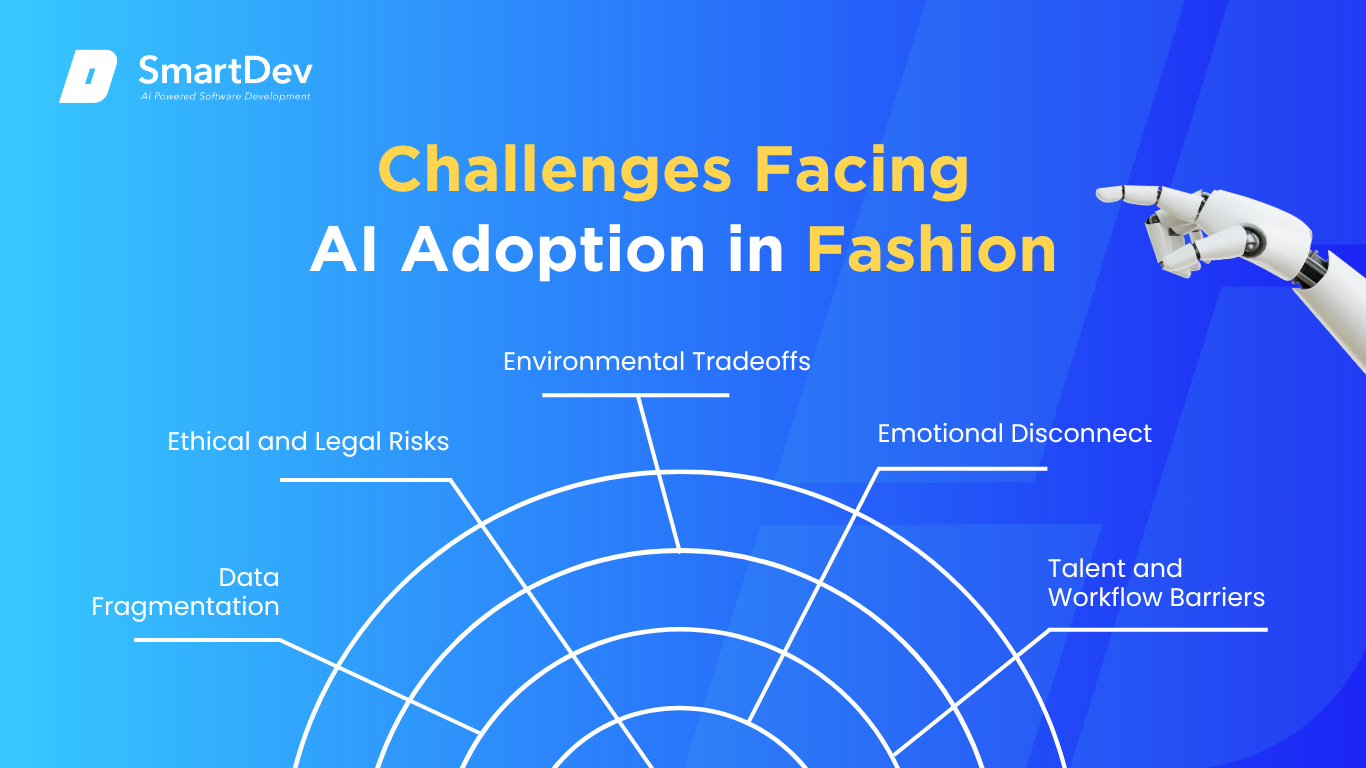
1. Data Fragmentation
Fashion brands often store product, customer, and trend data across disconnected systems and formats. Without unified, high-quality datasets, AI models struggle to deliver accurate predictions or recommendations. This lack of integration limits the value brands can extract from their AI tools.
Centralizing and cleaning this data requires coordination across design, marketing, and supply chain teams. It also demands ongoing maintenance to ensure consistency as new data flows in. Without clear ownership and governance, data fragmentation remains a major barrier to AI effectiveness.
To learn how unstructured data can be effectively leveraged in AI applications, check out our detailed guide on how AI unlocks the power of unstructured data.
2. Ethical and Legal Risks
As fashion brands experiment with AI-generated models and marketing content, they face growing concerns around authenticity and artistic integrity. For example, Vogue’s use of AI-generated models sparked backlash over transparency and creative ethics. Consumers and creatives alike question whether AI can reflect true diversity and expression.
On the legal side, global regulations are still evolving. The EU’s AI Act and the U.S. deregulatory approach create compliance uncertainty for global brands. Without clear frameworks, companies risk reputational damage or legal penalties.
Explore how ethical and explainability concerns are addressed in real-world deployments in our detailed guide on AI ethics concerns.
3. Environmental Tradeoffs
While AI can improve efficiency, it can also accelerate trend cycles and overproduction. Fast-fashion players using AI to quickly replicate styles risk increasing their environmental impact. Without checks in place, AI may reinforce unsustainable practices.
Brands must pair AI with responsible production and recycling initiatives. This includes monitoring carbon outputs, sourcing ethically, and using AI to support circular systems. Without conscious implementation, sustainability gains could be undermined.
4. Emotional Disconnect
AI lacks the emotional intelligence and cultural nuance of human stylists and designers. While it can suggest outfits or generate designs, these results may miss subtle cues like cultural relevance or personal storytelling. This can lead to generic or misaligned experiences.
Many customers still value human creativity and style intuition. Successful brands often combine AI efficiency with human curation to strike the right balance. Over-reliance on automation can risk alienating loyal audiences.
5. Talent and Workflow Barriers
Deploying AI tools requires specialized skills in machine learning, data science, and systems integration. Most fashion companies lack in-house talent to build or manage these systems effectively. Outsourcing can fill the gap but adds cost and complexity.
AI adoption also changes how teams work. Designers must shift from manual creation to overseeing AI-generated concepts, which requires training and mindset adjustments. Without proper onboarding and collaboration, adoption can stall or underdeliver.
Specific Applications of AI in Fashion
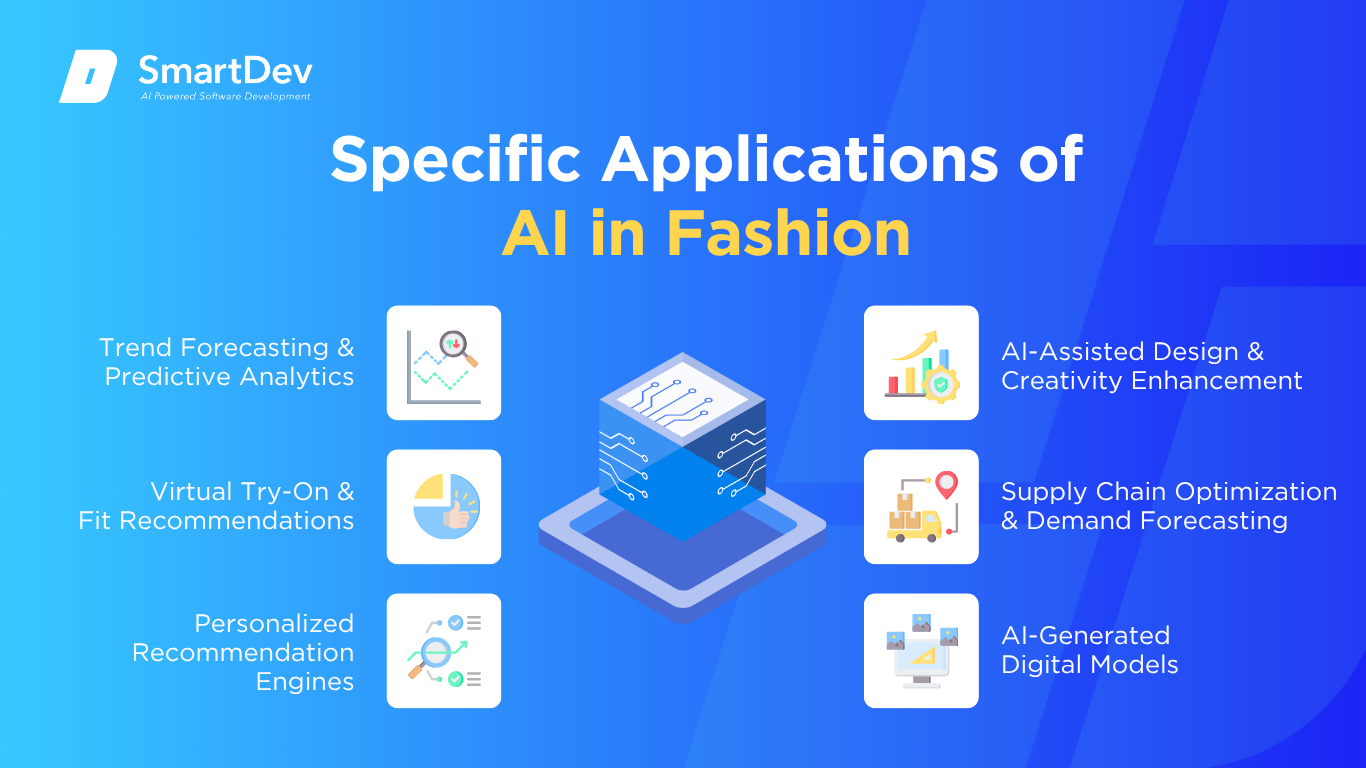
1. Trend Forecasting & Predictive Analytics
AI-powered trend forecasting allows fashion brands to predict consumer preferences and upcoming style movements using large datasets. It solves the common industry issue of overproduction and mismatched inventory by guiding design and inventory decisions. These systems gather data from social media, e-commerce platforms, runway shows, and global sales to detect emerging fashion trends.
The underlying AI methods include natural language processing (NLP) and machine learning algorithms trained to recognize sentiment, keywords, and pattern frequencies. Data from influencers, customer reviews, and fashion blogs are processed to predict what designs will be in demand. These insights are then integrated into the design and merchandising workflows of fashion houses.
Strategically, this enables brands to reduce guesswork, improve product-market fit, and decrease waste due to unsold stock. Brands that integrate AI forecasting systems can also shorten the product development cycle and align closely with real-time consumer demand. Ethical concerns include ensuring unbiased datasets that represent diverse fashion markets globally.
Real-world example:
Zalando implemented generative AI tools to rapidly produce editorial images aligned with real-time fashion trends. By 2024, over 70% of Zalando’s campaign visuals were AI-generated, cutting production lead time from weeks to days and reducing related costs by 90%.
2. Virtual Try-On & Fit Recommendations
Virtual try-on uses AI, computer vision, and augmented reality (AR) to simulate the experience of trying on clothes digitally. This addresses a major issue in online fashion: high return rates due to poor fit or appearance mismatch. It empowers customers to see garments on a digital avatar or even overlay items on live body images via smartphone cameras.
The AI methods powering this technology include pose estimation, 3D modeling, and real-time rendering. These systems often require garment texture data, user body dimensions, and high-fidelity imaging. It integrates into mobile apps or retail kiosks and functions seamlessly with e-commerce backend systems.
This improves customer satisfaction, reduces logistics costs associated with returns, and increases conversion rates. Retailers offering this feature also benefit from greater customer loyalty and digital engagement. Privacy and data usage policies must be transparent, especially when body scans or facial recognition is involved.
Real-world example:
Nike’s AI-powered Nike Fit uses smartphone scanning and machine learning to recommend optimal shoe sizing. It addresses the common issue of footwear returns due to size mismatch and significantly enhances customer confidence in digital purchases.
3. Personalized Recommendation Engines
Personalized recommendation engines use AI to tailor product suggestions to each customer, increasing relevance and likelihood of purchase. It solves the issue of decision fatigue and enhances the overall shopping experience by narrowing down options. Fashion retailers use behavioral data, purchase history, and browsing patterns to feed machine learning models.
These engines typically combine collaborative filtering with deep learning for image recognition and hybrid recommendation systems. Algorithms continuously update based on real-time user interactions, adjusting displays, email offers, and push notifications. It integrates into mobile apps, websites, and CRM systems to deliver a cohesive experience.
Benefits include higher conversion rates, increased cart size, and improved user engagement metrics. Additionally, it helps brands upsell and cross-sell items effectively while gaining insights into consumer preferences. Data protection and transparency about algorithmic targeting are necessary to maintain trust.
Real-world example:
Stitch Fix blends machine learning with human styling to curate personalized clothing selections for clients. The brand’s AI tools have helped increase average order value by 9% and maintain a customer retention rate of approximately 67%.
4. AI-Assisted Design & Creativity Enhancement
Generative AI is transforming the fashion design process by automating the creation of patterns, silhouettes, and new styles. Designers feed mood boards, trend data, and aesthetic preferences into generative adversarial networks (GANs) to create novel visuals. This solves the bottleneck of manual design iteration and enables quicker experimentation.
Technologies such as deep learning and computer vision allow these models to interpret visual cues and replicate design logic. The AI can generate hundreds of variations within seconds, supporting designers in visualizing new collections. Designers retain creative control while AI accelerates ideation and inspiration.
The result is faster prototyping, greater creative exploration, and reduced development costs. However, intellectual property considerations and maintaining brand originality remain critical. Proper labeling and internal policy are needed to delineate AI-generated elements from human designs.
Real-world example:
Tommy Hilfiger’s Reimagine Retail project, developed with IBM and FIT, used AI to analyze 15,000 runway and product images to inspire new designs. The collaboration reduced the design-to-sample cycle time by approximately 30%, enhancing speed and creativity in early design stages.
5. Supply Chain Optimization & Demand Forecasting
AI is revolutionizing fashion supply chains by enabling accurate demand forecasting and real-time logistics optimization. Traditional supply chains often suffer from delays and surplus inventory due to outdated forecasting methods. AI mitigates these challenges by analyzing past sales, consumer behavior, and external signals.
Demand forecasting models use supervised learning algorithms trained on multi-variable datasets, including weather, holidays, and regional events. These insights inform inventory allocation, replenishment schedules, and supplier coordination. Integration into ERP and SCM systems enables real-time decision-making and flexible manufacturing.
Strategic value includes minimized stockouts, optimized warehousing, and faster response to market changes. Retailers benefit from lean operations and reduced markdown rates. The main challenges are ensuring data quality, model retraining, and alignment with sustainability goals.
Real-world example:
Zara’s AI system tracks sales across 7,000+ stores, enabling rapid production adjustments and demand forecasting. This system allows Zara to restock stores within days and achieve up to 85% sell-through at full price, outperforming industry averages.
6. AI-Generated Digital Models (Virtual Influencers)
Fashion brands are using AI-generated digital models for marketing campaigns to reduce costs and enable scalable content production. These virtual influencers are created using 3D modeling and generative AI to replicate human appearance and expressions. They allow marketers to generate fashion visuals without organizing expensive photoshoots.
AI methods include GANs, photogrammetry, and body modeling algorithms. Brands can adjust outfits, poses, and backgrounds instantly, aligning visuals with target demographics. This is especially beneficial for fast-paced social media content cycles.
Virtual models reduce production time, allow creative flexibility, and promote inclusivity through customizable avatars. However, brands must navigate transparency, disclosure laws, and ethical concerns around replacing human talent. Audience reception also varies based on authenticity and realism of avatars.
Real-world example:
Zalando’s use of AI-generated digital models helped it reduce image production time while producing trend-relevant fashion content. By the end of 2024, over 70% of its editorial images were created using generative AI models, streamlining its marketing process.
Need Expert Help Turning Ideas Into Scalable Products?
Partner with SmartDev to accelerate your software development journey — from MVPs to enterprise systems.
Book a free consultation with our tech experts today.
Let’s Build TogetherExamples of AI in Fashion
AI is no longer just a futuristic concept in fashion, it’s driving real change in how brands operate and connect with customers. The following case studies highlight how top fashion companies are using AI to solve key challenges and deliver measurable results.
Real-World Case Studies

1. Stitch Fix: AI‑Powered Personal Styling & Inventory Intelligence
Stitch Fix combines machine learning with human stylists to curate clothing selections based on client surveys, purchase history, and ongoing feedback. Their recommendation engine improves assortment accuracy, contributing to high client satisfaction and sticky repeat behavior.
Their AI merchandising tool has enabled a 9% year-over-year increase in average order value (AOV) and a repeat customer rate of about two-thirds of the client base.
2. Nike: Nike Fit AI Virtually Solves Size Mismatch
Nike’s Nike Fit feature uses computer vision and machine learning to scan users’ feet and recommend the best shoe size among Nike styles. This innovation addresses size-related return issues, which historically account for up to one-third of online footwear returns.
The system achieves sub‑2 mm scanning accuracy and has materially improved customer confidence and sizing precision in both online and in-store shopping contexts.
3. Zara (Inditex): AI‑Driven Demand Forecasting & Inventory Control
Zara uses AI-based inventory analytics to track real-time sales and trend data across over 7,000 global stores, enabling fast restocking and agile replenishment cycles in just 10–15 days. Their optimized operations enable up to 85% of items to be sold at full price, significantly outperforming the typical retail average of ~60% sell-through.
This AI-powered approach helps Zara minimize overstock, elevate margin performance, and maintain rapid fulfillment aligned with consumer demand.
Innovative AI Solutions
AI is driving next-generation fashion innovation with tools that promote sustainability and enhance digital shopping. Companies like Refiberd use hyperspectral imaging and machine learning to identify fibers in complex fabrics, improving textile recycling accuracy. Named Circular Fashion Innovator of the Year, Refiberd’s AI technology helps scale circular fashion by reducing waste and enabling textile-to-textile reuse.
On the retail front, Perfect Corp. offers AI-powered virtual try-on experiences that don’t require 3D models, boosting online engagement and conversion. Estée Lauder reported a 2.5× lift in conversions using Perfect Corp.’s tools, reducing return rates and improving customer satisfaction. These innovations are transforming fashion by making shopping smarter, faster, and more sustainable.
AI-Driven Innovations Transforming Fashion
Emerging Technologies in AI for Fashion
AI is revolutionizing how fashion is designed, produced, and sold by enabling brands to make data-driven decisions with unprecedented speed and precision. Generative AI allows designers to experiment with countless styles, patterns, and cuts in a fraction of the time it used to take. This empowers creative teams to test and validate new ideas rapidly, cutting down on costs and reducing time-to-market.
Meanwhile, computer vision is reshaping the way fashion companies interact with visual data. AI models can now analyze customer images and predict sizing more accurately, helping to reduce return rates and enhance customer satisfaction. These technologies are not only improving operational efficiency but also transforming the online shopping experience into something far more personalized and engaging.
AI’s Role in Sustainability Efforts
Sustainability in fashion is seeing real progress thanks to intelligent data-driven systems. By forecasting demand with greater accuracy, brands can avoid overproduction, significantly reducing textile waste and unsold stock. This shift not only supports environmental goals but also leads to more efficient, cost-effective operations.
Energy efficiency is another area where intelligent automation is making a difference. Smart systems detect inefficiencies in production and logistics, making real-time adjustments to reduce energy usage without sacrificing performance. The result is a more sustainable supply chain that aligns with both environmental standards and business growth.
How to Implement AI in Fashion
Implementing AI in fashion isn’t just a technology upgrade, it’s a strategic transformation. To get it right, you need a clear roadmap that aligns your goals, data, tools, and teams from the very start.
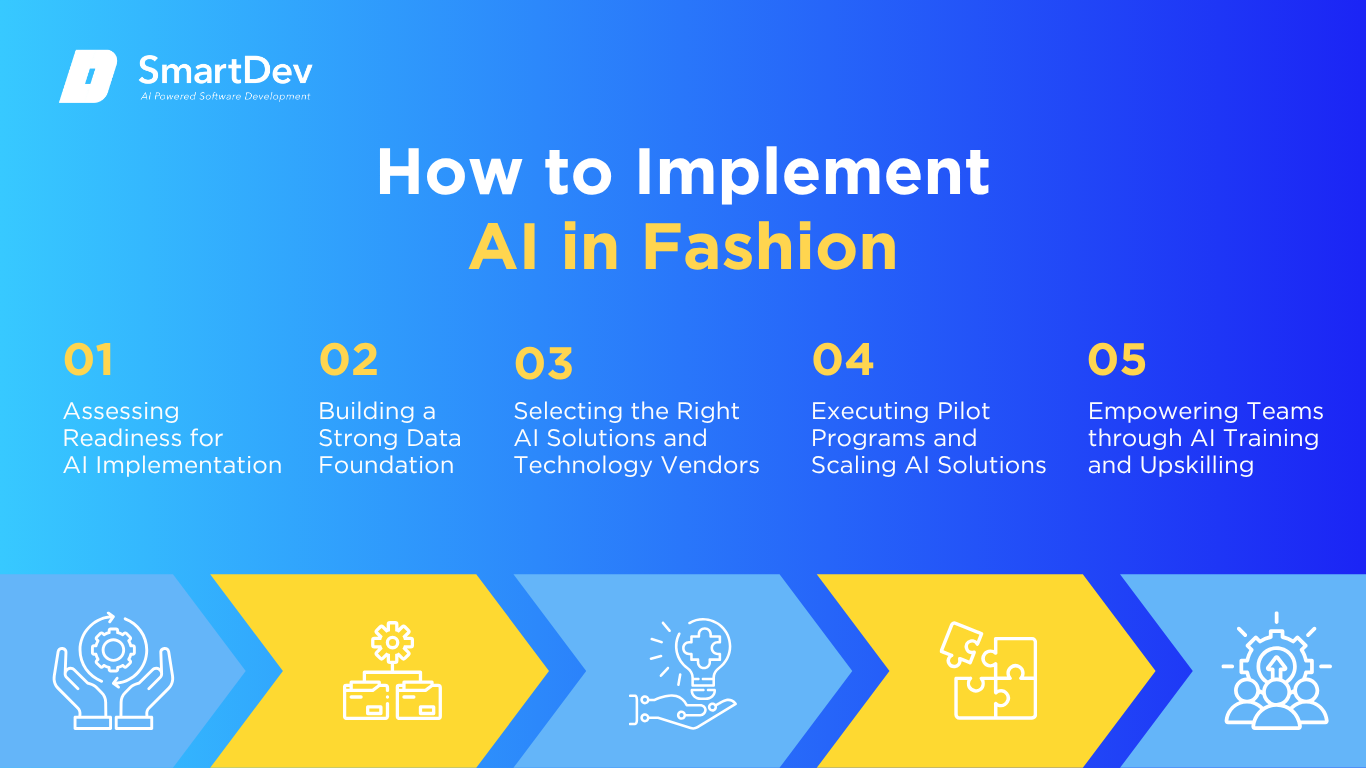
Step 1: Assessing Readiness for AI Adoption
Before adopting AI in fashion, it’s crucial to understand your organization’s current level of digital maturity. Focus on departments where repetitive, manual work is slowing down operations, like managing product data, demand forecasting, or inventory planning. These areas often yield the fastest returns and are ideal places to begin AI experimentation.
Evaluate your leadership’s commitment and team culture as well. Integrating AI means rethinking workflows and potentially challenging long-held creative traditions. Without a clear strategy and executive buy-in, even promising AI pilots may stall before reaching scale.
Explore our data analytics services to see how we help businesses implement AI solutions that scale.
Step 2: Building a Strong Data Foundation
AI thrives on structured, high-quality data, and fashion companies need to treat data as a core asset. This includes organizing everything from product specs and sales records to customer behavior and return rates into consistent, accessible formats. When your data is clean and centralized, AI models can generate faster and more reliable insights.
Data governance plays an equally important role in ensuring privacy and consistency across global teams. Establish clear rules on how data is collected, stored, and used, especially in areas like personalization or virtual fitting. A robust foundation paves the way for scalable AI strategies with real business impact.
Explore why clean, well-governed data is the foundation of successful AI adoption in our data management guide.
Step 3: Choosing the Right Tools and Vendors
Finding the right AI partner goes beyond picking the flashiest tech. Look for vendors who understand the fashion industry’s unique rhythms – from seasonality and style shifts to complex supply chains. The best solutions should integrate seamlessly with your existing platforms and grow with your business.
Transparency is also key when it comes to how these tools use your data. Be clear on ownership, access, and security, especially when dealing with customer-facing applications. A trustworthy vendor not only provides cutting-edge tools but also long-term support and strategic guidance.
Step 4: Pilot Testing and Scaling Up
Start small by testing AI in controlled environments where results are easy to measure. This might mean using predictive analytics to guide merchandising or applying visual AI to assist with digital lookbooks. A contained pilot helps uncover technical challenges and build internal confidence.
Once you’ve proven value in one area, it becomes easier to expand across departments or regions. Use what you learn to refine your rollout strategy and align teams around a shared vision. Scaling with a clear roadmap ensures smoother transitions and better ROI.
Step 5: Training Teams for Successful Implementation
Successful AI integration isn’t just about the tech, it’s about the people using it. Offer training programs that show how AI can support, not replace, human creativity. Focus on practical applications, so teams feel empowered, not threatened, by automation.
Encourage collaboration between technical experts and creative professionals. When both groups share insights, AI becomes a natural extension of your team rather than an isolated tool. A confident, well-trained workforce is essential for long-term AI success in fashion.
To get started, check out our detailed guide on how tech leads can assess and drive AI adoption.
Measuring the ROI of AI in Fashion
Key Metrics to Track Success
Measuring ROI in fashion AI goes beyond surface-level analytics, it requires a focus on core performance indicators that reflect both cost efficiency and business value. Key metrics often include conversion rate improvements, reductions in product return rates, and enhanced forecast accuracy. Each of these helps illustrate how AI contributes to better customer experiences and operational precision.
Financial impact is equally important. Brands are seeing tangible benefits in reduced overproduction, shorter design cycles, and lower labor costs through automation. By tracking these gains over time, fashion companies can determine where AI has the greatest strategic value and where to expand its use.
Case Studies Demonstrating ROI
Stitch Fix leverages predictive algorithms and stylist input to deliver personalized fashion selections, resulting in a 30% drop in return rates and stronger customer loyalty. With annual revenue reaching $1.6 billion, much of its success stems from AI-enabled inventory efficiency and better size matching.
Perry Ellis saw major efficiency gains by partnering with Six Atomic to automate pattern design, cutting SKU launch time by 95%. In a separate AI trial with Yotpo, the brand boosted conversions by 25% and lifted revenue per session by 12%, validating how AI can drive both digital engagement and operational savings.
Common Pitfalls and How to Avoid Them
While the rewards of AI are real, many brands stumble when the technology is introduced without clear objectives or sufficient data readiness. Inconsistent data, siloed departments, or poor system integration often lead to underwhelming results. These challenges can erode internal confidence and stall broader adoption.
Ethical risks and creative tensions can also become barriers, especially when using AI-generated models or content without transparent oversight. Concerns around representation, intellectual property, and labor impact need to be addressed thoughtfully. Avoiding these pitfalls requires clear governance, inclusive design processes, and a commitment to aligning AI use with long-term brand values.
Learn how to evaluate AI model effectiveness and ROI with our practical guide on AI performance metrics.
Future Trends of AI in Fashion
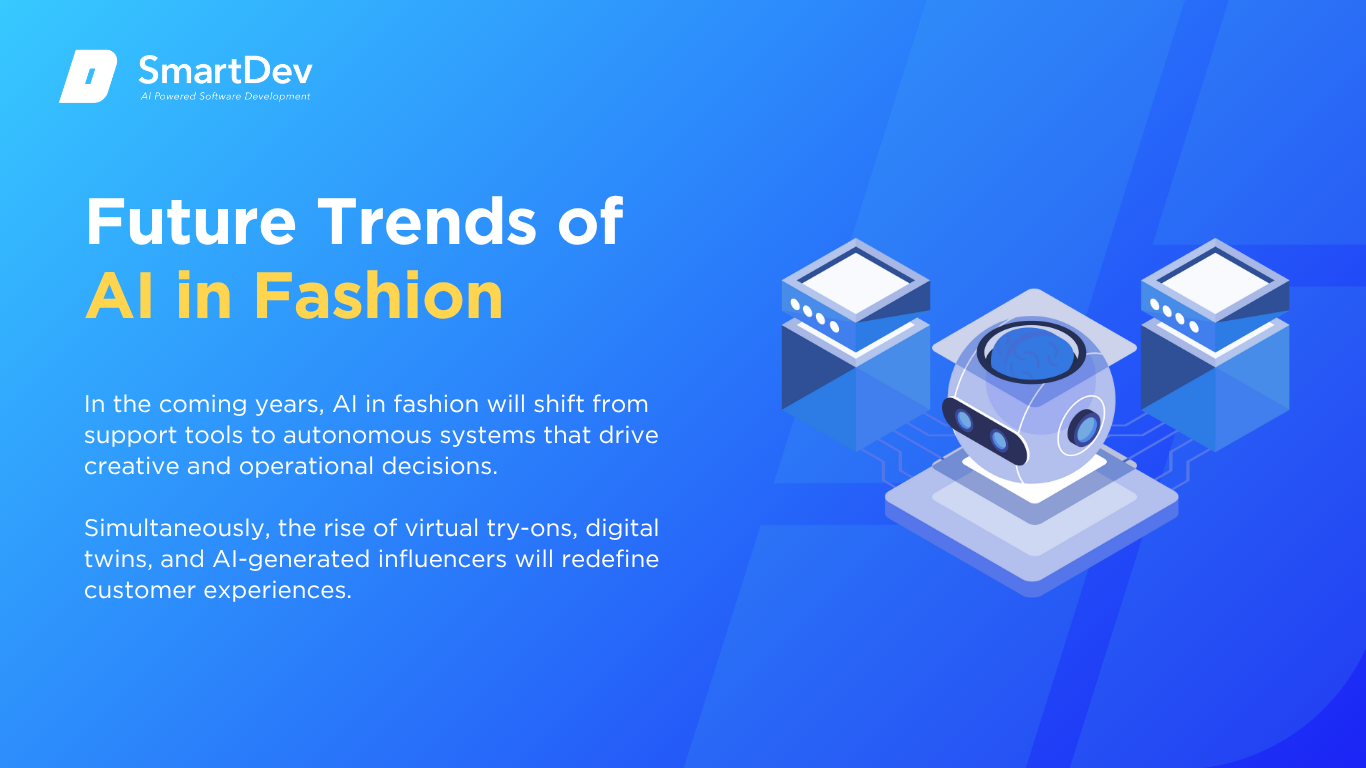
Predictions for the Next Decade
In the coming years, AI in fashion will shift from support tools to autonomous systems that drive creative and operational decisions. Brands like LVMH are exploring “agentic AI” capable of trend forecasting, campaign generation, and inventory management with minimal human input. This evolution positions AI as a strategic asset that influences everything from design to supply chain.
Simultaneously, the rise of virtual try-ons, digital twins, and AI-generated influencers will redefine customer experiences. As regulations like the EU AI Act take shape, brands will need to prioritize ethical deployment and data transparency. The future of fashion will depend on balancing innovation with accountability.
How Businesses Can Stay Ahead of the Curve
To remain competitive in the AI-driven future of fashion, businesses need to adopt a proactive and flexible mindset. This means investing in adaptable AI infrastructure, fostering a culture of experimentation, and aligning technology with long-term brand goals. Companies that continuously test, learn, and refine their AI strategies will be better equipped to respond to shifting consumer expectations.
Staying ahead also requires responsible implementation. Prioritize ethical data use, transparency in AI applications, and inclusivity in creative outputs. By combining innovation with accountability, forward-thinking fashion brands can lead the next wave of transformation – setting standards not just in style, but in trust and impact.
Conclusion
Key Takeaways
AI is reshaping the fashion industry by enhancing design, streamlining operations, and personalizing the customer journey. With proven results in reducing returns, accelerating product development, and increasing conversion rates, the value of AI is clear and measurable. From generative design to smart supply chains, its impact spans the entire business.
To unlock these benefits, brands need clean data, the right technology partners, and well-prepared teams. Success lies in combining innovation with strategic planning and ethical execution. When done right, AI becomes not just a tool, but a competitive advantage.
Moving Forward: A Strategic Approach to AI-Driven Transformation
As AI reshapes the fashion industry, now is the time to rethink how your brand approaches design, production, and customer engagement. From minimizing waste and accelerating go-to-market timelines to personalizing shopping experiences at scale, AI is no longer a future consideration, it’s a strategic necessity for staying competitive.
At SmartDev, we help fashion brands harness the full power of AI with tailored solutions that align with your goals. Whether you’re digitizing your supply chain, launching smart personalization tools, or integrating virtual try-on technology, we ensure your AI journey delivers measurable results and brand impact.
Explore our AI-powered software development services to learn how we support businesses across industries with scalable, intelligent solutions tailored to their unique goals.
Contact us today to learn how we can help your brand lead with innovation, efficiency, and sustainable growth through AI.
—
References:
- The Year Ahead: How Gen AI Is Reshaping Fashion’s Creativity | The Business of Fashion
- Generative AI in fashion market over 2 billion USD by 2032 | Fashion United
- AI in Fashion Market Size and Forecast 2025 to 2034 | Precedence Research
- Virtual try-on offers more sales: Perfect Corp. | Retail Dive
- Refiberd wins the CFDA x Ebay Circular Fashion Fund | Vogue Business
- Artificial Intelligence Empowers Designers In IBM, Tommy Hilfiger And FIT Collaboration | Forbes
- Zalando uses AI to speed up marketing campaigns, cut costs | Reuters
- Nike Unveils ‘A Game-Changing Innovation’: A Fit Feature To Fix Shoe Sizing Online And In-Store | Forbes
- Calling all fashion models … now AI is coming for you | The Guardian







